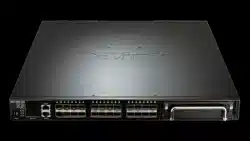Loading ...
Loading ...
Loading ...

DXS-3600 Series 10GbE Layer 2/3 Switch CLI Reference Guide
685
Appendix C - Trap Entries
This table lists the trap logs found on the Switch.
Category Trap Name Description OID
VRRP vrrpTrapNewMaster The newMaster trap indicates that the
sending agent has transitioned to
'Master' state.
Binding objects:
(1) vrrpOperMasterIpAddr
1.3.6.1.2.1.68.0.1
vrrpTrapAuthFailure A vrrpAuthFailure trap signifies that a
packet has been received from a router
whose authentication key or
authentication type conflicts with this
router's authentication key or
authentication type. Implementation of
this trap is optional.
Binding objects:
(1) vrrpTrapPacketSrc
(2) vrrpTrapAuthErrorType
1.3.6.1.2.1.68.0.2
MSTP newRoot The newRoot trap indicates that the
sending agent has become the new
root of the Spanning Tree; the trap is
sent by a bridge soon after its election
as the new root, e.g., upon expiration
of the Topology Change Timer,
immediately subsequent to its election.
Implementation of this trap is optional.
1.3.6.1.2.1.17.0.1
topologyChange A topologyChange trap is sent by a
bridge when any of its configured ports
transitions from the Learning state to
the Forwarding state, or from the
Forwarding state to the Blocking state.
The trap is not sent if a newRoot trap is
sent for the same transition.
Implementation ofthis trap is optional.
1.3.6.1.2.1.17.0.2
Port Trap linkUp A notification is generated when port
linkup.
Binding objects:
(1) ifIndex,
(2) if AdminStatus
(3) ifOperStatu
1.3.6.1.6.3.1.1.5.4
linkDown A notification is generated when port
linkdown.
Binding objects:
(1) ifIndex,
(2) if AdminStatus
(3) ifOperStatu
1.3.6.1.6.3.1.1.5.3
Start Trap coldStart A coldStart trap signifies that the
SNMPv2 entity, acting in an agent role,
is reinitializing itself and that its
configuration may have been altered.
1.3.6.1.6.3.1.1.5.1
warmStart A warmStart trap signifies that the
SNMPv2 entity, acting in an agent role,
is reinitializing itself such that its
configuration is unaltered.
1.3.6.1.6.3.1.1.5.2
Loading ...
Loading ...
